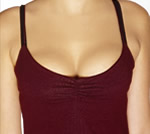צחצוח שינים במברשת רגילה (Butler® GUM 311) התגלה כהרבה (!) יותר יעיל מאשר צחצוח במברשת חשמלית(The Interplak ELB20TCS i-brush ) לדעתי האישית -המברשת של butler היא מברשת מעולה ואילו i-brush היא מברשת לא מוצלחת לאנשים מבוגרים . המלצתנו על מברשת חשמלית, למתרפאים אשר לא מצליחים לצחצח כראוי,צריכה להתבסס באופן אישי ,לאור המבחר הגדול שקיים בשוק . Journal Of Clinical Periodontology The plaque-removing efficacy of a finger brush (I-Brush®) M. P. Graveland, N. A. M. Rosema, M. F. Timmerman and G. A. Van der Weijden Objective: The purpose of the present study was to test the effectiveness of a finger toothbrush (I-Brush®) in removing plaque compared with a flat-trimmed manual toothbrush. Material and methods: For this study, 37 subjects were selected, without previous experience of the use of the I-Brush®. Each subject received a finger brush (I-Brush®), a manual toothbrush (Butler® GUM 311), two written brushing instructions for both types of brushes, and a brush calendar. Subjects were given a period of 3 weeks to become familiar with the two types of brushes. During this period, the subjects were instructed to use the two types of brushes on alternate days. The brush calendar helped as a reminder and served to ensure compliance. No instructions regarding brushing time or frequency of brushing were given to the subjects, except that they should conform to their usual oral habits. After 3 weeks, all subjects were asked to abstain from oral hygiene procedures for 48 h prior to the experiment. In this experiment, the amount of dental plaque was scored by a trained examiner. The examiner (N.A.M.R.) used the modified Silness & Löe (1964) plaque index at six sites per tooth. After scoring, each subject received a new finger brush and a new manual toothbrush. The subjects brushed according to a split mouth protocol. Two contra-lateral quadrants were chosen randomly and were brushed with one randomly chosen brush and the two opposing contra-lateral quadrants with the alternate brush. The brushing was performed under supervision in front of a mirror. The available time for brushing was 2 min. for the entire dentition. Finally, the remaining plaque was scored again. Results: The overall reduction in plaque was 79% for the manual toothbrush and 62% for the finger brush. The plaque removing efficacy of the finger brush was poorest at the approximal vestibular surfaces (55% plaque reduction) compared with the manual toothbrush (77% plaque reduction). Conclusion: The plaque reduction of the finger brush is not an acceptable alternative to the use of a regular manual toothbrush. |

עליה של עשרות אחוזים בשיעורי התמותה על-רקע היריון בשנים האחרונות בארצות הברית (JAMA Netw Open)
בארצות הברית דווח על שיעורי התמותה על-רקע היריון הגבוהים ביותר מבין המדינות בעלות הכנסה-גבוהה, עם למעלה מ-6,000 מקרי תמותה מדווחים בין 2018 עד 2022, כך על-פי נתונים שפורסמו בכתב העת JAMA Network Open. מניתוח הנתונים עלה כי בילידות אלסקה ובאמריקאיות ממוצא אינדיאני תועדו שיעורי התמותה הגבוהים ביותר. מחקר החתך התבסס על נתונים ארציים של המרכז […]














השאירו תגובה
רוצה להצטרף לדיון?תרגישו חופשי לתרום!